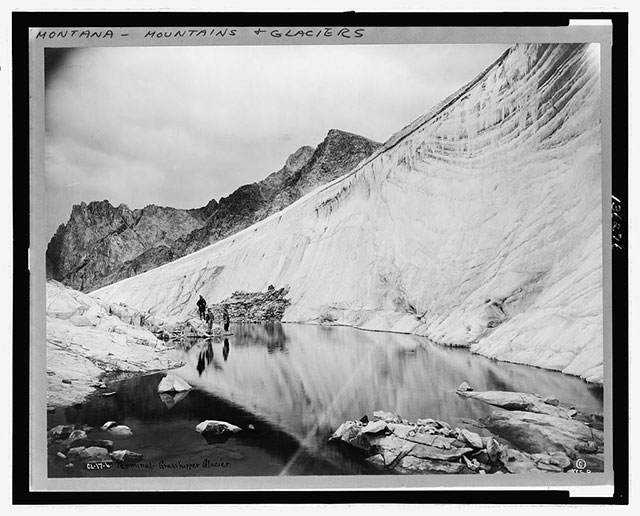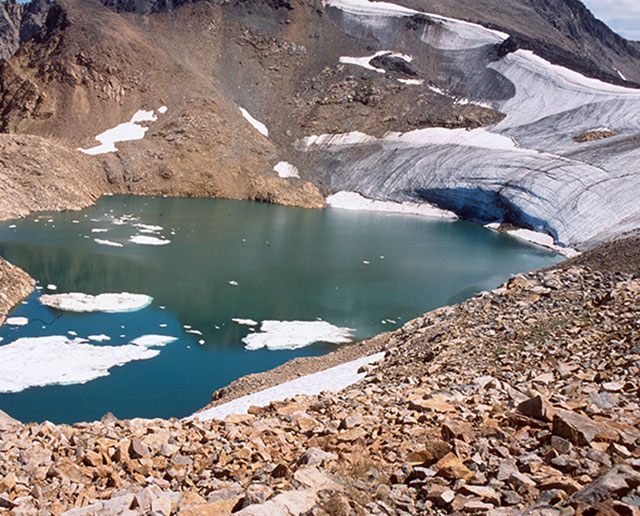Climate Change
Warm and Erratic: Threats to Wilderness from Climate Change
The magnitude and complexity of human-facilitated global warming make it challenging to track all the specific impacts it’s having on wilderness areas. Those impacts, without question, will be substantial—and they’re certainly already underway.
As they unfold, the value of wilderness as a reference point for trying to understand the reverberations of humanity on ecological processes only magnifies.

Grasshopper Glacier in the Absaroka-Beartooth Wilderness in 1916

Grasshopper Glacier in the Absaroka-Beartooth Wilderness in 2009
The Many Dimensions of Climate Change Impacts
Climate change is such an all-encompassing, biosphere-level phenomenon that many of the threats discussed elsewhere in this section are affected by it.
For example, longer stretches of higher temperatures, reduced and quicker-melting snowpacks, more extreme droughts, and other climate shifts are thought to be contributing to larger, more frequent, and more intense wildfires in the American West. One assessment of large (bigger than 405 hectares) wildfires in the region from 1984 through 2011 showed an increase of seven fires per year and an annual increase in total fire area of 137 square miles. The authors of that study noted that other factors besides climate change were likely involved in that trend—fire-suppression efforts by land-management agencies, for instance—but suggested, “Even so, these changes in fire activity are a reflection of long-term, global fire trends that will likely occur with increased temperature and drought severity in coming decades.”
Social Impacts
There are also the social impacts of climate change’s effect on wilderness: in other words, the impact on particular human activities, economies, and values that stem from climate-related ecological phenomena. These might include changes in the distribution or abundance of fish and game species, and/or changes to their habitat, with consequences for hunters and anglers. Whether it’s a wild beach threatened by sea-level rise, ramped-up wildfires diminishing access to a treasured hiking area, or a mild winter stymying cross-country skiers and snowshoers, the effects of climate change on wilderness areas also impact outdoor recreation.

Far more wide-reaching is the influence of a changing climate on the ecosystem services wilderness provides for human well-being: from clean water to clean air.
Climate Change & Species
By fundamentally altering local environments, global warming could also influence the distribution of organisms in wildernesses. Rising temperatures and their attendant ecological impacts could drive species upslope or out of a region entirely. Higher-elevation plants and animals may ultimately have no place to go and end up going locally extinct.
Organisms, of course, can adjust to changing climate: it’s a reality of life on Earth that’s been going on for millions of years. However, the unusual rate of anthropogenic global warming is likely to hinder the ability of some species to migrate to new territory or genetically adapt to the new environment.
Resident species may find themselves under threat from newcomers expanding their range under the changing climate: competitors, predators, and potential pathogens.
Climate-related threats from other organisms needn't come from non-native or colonizing species. For example, the mountain pine beetle--a bark beetle that kills the pines it bores into to reproduce--is indigenous to the western U.S. and Canada, but the region’s cold winters and short summers served as a natural check on major outbreaks. Recent decades, however, have seen large epidemics of pine-beetle infestation in the Rocky Mountains that that have killed tens of millions of acres of pine forest--from mid-elevation ponderosa woods to subalpine whitebark-pine groves. This has impacted many wildernesses across the West, from the Black Elk Wilderness in the South Dakota Black Hills to the Mount Massive Wilderness in the Colorado Rockies. Ecologists suspect milder winters and longer, hotter summer temperatures, which enhance the beetle’s survival and fertility, are among the leading causes of this epic transformation of western conifer ecosystems.
Wilderness Management in the Face of Climate Change
Because of the breadth and scale of its biophysical consequences, climate change poses a whole tangle of fundamental questions about wilderness areas. Many have interpreted the purpose of the Wilderness Act as preserving regions free of significant human impact, but human-induced climate change affects every corner of the planet, from remote high-elevation glaciers to the depths of the ocean.
A changing climate will continue to impact our wilderness areas: shifting the species composition of ecosystems, converting one ecosystem or biome into another (e.g. forest to scrub or steppe), altering watershed hydrology and ecological-disturbance regimes, etc.
Wilderness managers must grapple with how to respond to these changes—or whether to respond at all. They’ll have to weigh an active, hands-on approach—like culling invasive species or fighting larger, fiercer wildfires—against a passive, hands-off approach. It’s the classic dilemma of wilderness management made all the more complicated—and pressing—by global warming’s across-the-board footprint.
As Elisabeth Long and Eric Biber write in The Wilderness Act: Climate Change Adaptations: “At heart, climate change and other indirect human effects on wilderness areas create a tension between maintaining the historic natural state of the wilderness area and avoiding human intervention in the wilderness area.”
This touches on core concepts of the formal wilderness definition in the Wilderness Act, including wilderness’s untrammeled character and naturalness. If, as is widely accepted, untrammeled refers to the absence of “intentional modern human control or manipulation,” the unintentional anthropogenic impacts of climate change on a landscape wouldn't necessarily invalidate its wilderness character. But the question remains whether active management to counter those climate-change impacts would.
Because climate change will modify wildernesses from their “historical” ecological conditions, many argue this commonly used benchmark of naturalness—an arbitrary one, regardless, because of the reality of ecological change over time, with or without human influences—can’t guide management decisions. In 2010, Hobbs et al. proposed replacing naturalness with “a pluralistic approach that incorporates a suite of guiding principles, including historical fidelity, autonomy of nature, ecological integrity, and resilience, as well as managing with humility.”
Resilience has been defined as “an ecosystem’s ability to maintain self-organizing properties in the face of perturbations,” while ecological integrity “emphasizes a broad suite of ecological indicators that represent intactness and healthy functioning ecosystems.”
Climate Change & Wilderness: Identifying Management Goals & Weighing Impacts
In Responding to Climate Change on National Forests: A Guidebook for Developing Adaptation Options, Peterson et al. discuss four different management approaches in the face of climate change: resistance, resilience, response, and realignment. They write (emphasis ours):
The resistance strategy includes actions that enhance the ability of species, ecosystems, or environments (including social) to resist forces of climate change and that maintain values and ecosystem services in their present or desired rates and conditions. The resilience strategy enhances the capacity of ecosystems to withstand or absorb increasing impact without irreversible changes in important processes and functionality. The response strategy works directly with climate-induced changes to assist transitions to future states by mitigating and minimizing undesired and disruptive outcomes. The realignment strategy uses restoration techniques to enable ecosystem processes and functions (including conditions that may or may not have existed in the past) to persist through a changing climate.
Then there’s the strategy of doing nothing at all, a hands-off approach erring on the side of restraint in order to preserve a wilderness’s “untrammeled” quality by minimizing intentional human intervention.
Long and Biber’s legal review suggested the Wilderness Act serves as “a thumb on the scale in favor of restraint and passive management [that] may be particularly important, given the uncertainty about what kinds of active management techniques might be effective, the possible negative effects of active management on other resources, and the political and bureaucratic pressures that might otherwise lead to the overuse of active management in response to climate change.” But it also concluded “the Act allows for responses in situations where we are more certain that actions will be effective and the benefits of active management are worth the costs”.
To determine whether, how, and how much to intervene in wilderness processes in the face of climate change and other pressures, Naficy et al. (2016) suggested a framework consisting of (1) rigorously defined management goals; (2) a parsing out and testing of the “ecological assumptions underlying management approaches”; and (3) consideration of “the balance of potential benefits and harms that are associated with intervention actions”.
To aid wilderness managers in using such a framework, Peter Landres, Beth Hahn, and colleagues have created an Ecological Intervention and Site Restoration Toolbox with agency-specific guidelines on evaluating the scale of a proposed management action and its potential impact on clearly defined indicators of wilderness character.
The Future of Wilderness Under a Changing Climate
Deciding how to intervene in wilderness (if at all) in the interest of climate-change resilience will be an ongoing challenge, and there is unlikely to be any one-size-fits-all approach (hence the value of such a step-by-step, site-specific assessment as in the abovementioned toolbox). We can and must expect wildernesses to change in the face of global climatic trends.
As governments, institutions, and communities muster to the unprecedented task of both mitigating and adapting to climate change impacts, the importance of wilderness as a benchmark and natural laboratory will only grow. Wilderness offers unique opportunities to track ecological resilience in action: big wildfires restoring a kind of forest or shrubland less prone to future big wildfires, a sub-population of trees demonstrating genetic resistance to a pathogen ravaging its species, a mangrove swamp or salt marsh buffering a seacoast from tropical storms that may be ramped up by warmer ocean temperatures.
The changes wrought on wilderness landscapes by global warming will also be instructive, providing lessons applicable elsewhere. And, of course, wilderness as a reservoir for carbon-absorbing plant life, unpolluted freshwater, and biodiversity can help preserve these life-sustaining resources.